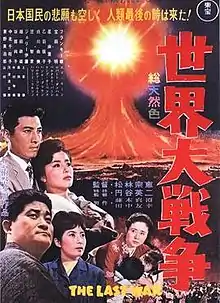The Last War (1961 film)
The Last War (世界大戦争, Sekai Daisensō, lit. "The Great World War") is a 1961 Japanese film directed by Shūe Matsubayashi. Released by Toho, it was their second highest-grossing film of the year.
| The Last War | |
|---|---|
 | |
| Directed by | Shūe Matsubayashi |
| Produced by | |
| Screenplay by |
|
| Starring | |
| Music by | Ikuma Dan[1] |
| Cinematography | Rokuro Nishigaki[1] |
Production company | |
| Distributed by | Toho |
Release date |
|
Running time | 109 minutes[1] |
| Country | Japan |
Plot
The film begins with a narration over shots of a modern-day Tokyo, noting that 16 years have passed since the end of World War II, and Japan has achieved rapid recovery. Mokichi Tamura works as a driver for a press center, hoping for happiness for his family. His daughter, Saeko, is in love with a merchant, Takano, who has been at sea for a long time. When he returns, the young couple agree to get married with the consent of Saeko's father.
Meanwhile, tensions between the Federation and the Alliance (fictional stand-ins for the US/NATO and the USSR/Warsaw Pact, respectively) build, especially after an intelligence-gathering vessel is captured. A new Korean War breaks out across the 38th parallel but is quickly stopped. Although Japan calls on both sides to seek peace, government officials think that the country could be ripe for Alliance retaliation in light of its open support for the Federation.
Dogfights between Federation and Alliance fighters over the Arctic (with both sides using nuclear-tipped air-to-air missiles) are just the beginning of a renewed conflict. Soon after an armistice agreement is concluded between North Korea and South Korea, tensions begin to erupt again because of the fighting between the two Koreas. The efforts of the military to overcome the war are fruitless. In addition, Japan's missile warning begins to mount in Japan, and the anxiety of the people reaches a peak.
Five ICBMs are eventually launched from both sides in the climax of the escalating war, with targets being major cities around the world including Tokyo, London, Paris, New York and Moscow. The Tamura family stay behind in the midst of the city's panic and hold a final dinner. That night, Tokyo is enveloped in a flash of nuclear light and blown apart, with the ground being torn asunder by the explosion and resulting in a violent volcanic eruption that almost completely consumes the wreckage of the city. Tamura and his family are killed by the detonation over Tokyo as their house is blown away by the ensuing fireball. Shortly after Tokyo is destroyed, the remaining four missiles strike their targets, obliterating all of them. The next morning after Tokyo's decimation, Takano's ship changes course to arrive at the remains of the destroyed city, prepared to die by the intense radioactive fallout. The ship's chaperone and Takano break down as the enduring events of what has happened become realised. The last shot shows Tokyo, now an immense crater, with the remains of the Diet Building at the centre and a warning laid over the screen, asking for the events in this film never to happen.
Cast
- Frankie Sakai as Mokichi Tamura
- Akira Takarada as Takano
- Yuriko Hoshi as Saeko Tamura
- Nobuko Otowa as Tamura's wife
- So Yamamura as Prime Minister of Japan
Production
The film had been a goal of Toho producer Tomoyuki Tanaka’s for some time, using a script by screenwriter Shinobu Hashimoto, featuring the Cold War escalating to World War III from the perspective of an every-man and his family. As work progressed, it was discovered that Toei had produced a similar film, World War III Breaks Out, dealing with identical subject matter. The two companies created their films as a form of competition, with Toho selecting Shue Matsubayashi as director of their film.[2]
City destruction scenes were created using a variety of techniques. Nuclear attacks on Tokyo, New York, Paris, Moscow and London were done by blowing compressed air upwards at an upside-down miniature. These scenes were reused in films such as Prophecies of Nostradamus. Miniatures such as the Kremlin were made of wafers. Tokyo’s destruction sequence used molten iron and flammable charcoal.[2]
Release
The Last War was released in Japan on October 8, 1961 where it was distributed by Toho.[1] The film was Toho's second highest-grossing film of 1961 and the ninth highest grossing Japanese film in 1961.[1] The film earned ¥284.9 million domestically.[3]
The English version/dubbing of The Last War has only been released on VHS and is currently the only home video release of the film in the United States. Germany has seen a DVD release in 2008, under the title of Todesstrahlen aus dem Weltraum (translation: Death Rays from Outer Space).[4]
References
Footnotes
- Galbraith IV 2008, p. 186.
- Tōhō tokusatsu eiga daizenshū. Tōhō Kabushiki Kaisha., 東宝株式会社. (Shohan ed.). Tōkyō. 28 September 2012. ISBN 978-4-86491-013-2. OCLC 811560583.CS1 maint: others (link)
- Kinema junpo besuto ten hachijugokai zenshi : Senkyuhyakunijuyon nisenjuichi. Kinemajunposha. 2012. ISBN 978-4-87376-755-0. OCLC 825139407.
- https://ssl.ofdb.de/view.php?page=fassung&fid=18220&vid=251892
Sources
- Galbraith IV, Stuart (1996). The Japanese Filmography: 1900 through 1994. McFarland. ISBN 0-7864-0032-3.
- Galbraith IV, Stuart (2008). The Toho Studios Story: A History and Complete Filmography. Scarecrow Press. ISBN 978-1461673743. Retrieved October 29, 2013.
External links
- The Last War at IMDb
- "世界大戦争 (Sekai daisenso)" (in Japanese). Japanese Movie Database. Retrieved 2007-07-16.
- The Last War online, Japanese language with English subtitles.